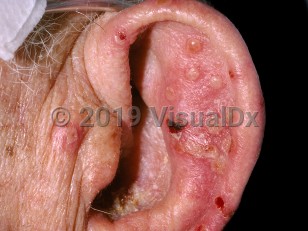Disseminated herpes simplex virus in Adult
Alerts and Notices
Important News & Links
Synopsis

This topic discusses disseminated herpes simplex virus in adults and children. Neonatal herpes simplex virus is addressed separately.
Infection with herpes simplex virus type 1 or herpes simplex virus type 2 (HSV-1 or HSV-2) usually presents as discrete groups of painful vesicles on orolabial or genital skin. However, in some instances, HSV infection may be diffuse, involving multiple sites of the body (skin and mucosa) and/or internal organ systems. When multiple regions of skin and/or internal viscera are concomitantly infected, the disease is termed disseminated HSV. It should be noted that a high index of suspicion is necessary for diagnosis in some cases as skin lesions may be absent.
Clinically, disseminated HSV may present as a widespread eruption of vesicles, pustules, and/or erosions, although cases of disseminated organ involvement without mucocutaneous lesions exist. Constitutional symptoms often occur and commonly consist of fever and regional lymphadenopathy. Involvement of ocular mucosa can cause viral conjunctivitis or keratitis. Disseminated disease can be associated with internal organ involvement. Organs potentially affected include the liver (viral hepatitis), lungs (pneumonitis), central nervous system (meningoencephalitis), heart (myocarditis), adrenal glands, bone marrow involvement (neutropenia or thrombocytopenia), kidneys, and gastrointestinal tract (necrotizing enterocolitis). Multiorgan failure and death can result. Prompt diagnosis and aggressive systemic antiviral therapy are keys to avoiding morbidity and mortality.
Two general groups of patients are at risk for developing disseminated HSV: patients with underlying skin disease and immunocompromised patients (such as from immunosuppression after organ transplantation, hematologic malignancies, or HIV / AIDS). In immunocompromised hosts, orofacial or genital lesions are not requisite in active disseminated HSV. Immunocompromised patients are at risk for more frequent and more severe HSV infections, involvement of internal organs, lack of response to antiviral therapy, and longer duration of viral shedding. It should be noted that while much less common, disseminated HSV with visceral involvement, particularly hepatitis, has been described in the immunocompetent host and the diagnosis should be considered in the setting of acute fulminant liver failure of unknown etiology.
Acute generalized infection of previously damaged skin with HSV is known as eczema herpeticum, or Kaposi varicelliform eruption. This clinical picture may be seen in all age groups, but it most commonly occurs in the second and third decades. Most cases are due to HSV-1, but HSV-2 is also reported. Atopic dermatitis is the most common preceding condition, but the condition may also be seen in patients with other conditions / states that disrupt epidermal barrier such as Darier disease, pemphigus foliaceus, pityriasis rubra pilaris, Hailey-Hailey disease, congenital ichthyosiform erythroderma, mycosis fungoides, patients with burns, and after use of ultraviolet A (UVA) phototherapy.
Pregnant individuals with primary HSV infection are at increased risk for severe illness (ie, dissemination and hepatitis), particularly in the third trimester.
Related topic: herpes simplex virus
Infection with herpes simplex virus type 1 or herpes simplex virus type 2 (HSV-1 or HSV-2) usually presents as discrete groups of painful vesicles on orolabial or genital skin. However, in some instances, HSV infection may be diffuse, involving multiple sites of the body (skin and mucosa) and/or internal organ systems. When multiple regions of skin and/or internal viscera are concomitantly infected, the disease is termed disseminated HSV. It should be noted that a high index of suspicion is necessary for diagnosis in some cases as skin lesions may be absent.
Clinically, disseminated HSV may present as a widespread eruption of vesicles, pustules, and/or erosions, although cases of disseminated organ involvement without mucocutaneous lesions exist. Constitutional symptoms often occur and commonly consist of fever and regional lymphadenopathy. Involvement of ocular mucosa can cause viral conjunctivitis or keratitis. Disseminated disease can be associated with internal organ involvement. Organs potentially affected include the liver (viral hepatitis), lungs (pneumonitis), central nervous system (meningoencephalitis), heart (myocarditis), adrenal glands, bone marrow involvement (neutropenia or thrombocytopenia), kidneys, and gastrointestinal tract (necrotizing enterocolitis). Multiorgan failure and death can result. Prompt diagnosis and aggressive systemic antiviral therapy are keys to avoiding morbidity and mortality.
Two general groups of patients are at risk for developing disseminated HSV: patients with underlying skin disease and immunocompromised patients (such as from immunosuppression after organ transplantation, hematologic malignancies, or HIV / AIDS). In immunocompromised hosts, orofacial or genital lesions are not requisite in active disseminated HSV. Immunocompromised patients are at risk for more frequent and more severe HSV infections, involvement of internal organs, lack of response to antiviral therapy, and longer duration of viral shedding. It should be noted that while much less common, disseminated HSV with visceral involvement, particularly hepatitis, has been described in the immunocompetent host and the diagnosis should be considered in the setting of acute fulminant liver failure of unknown etiology.
Acute generalized infection of previously damaged skin with HSV is known as eczema herpeticum, or Kaposi varicelliform eruption. This clinical picture may be seen in all age groups, but it most commonly occurs in the second and third decades. Most cases are due to HSV-1, but HSV-2 is also reported. Atopic dermatitis is the most common preceding condition, but the condition may also be seen in patients with other conditions / states that disrupt epidermal barrier such as Darier disease, pemphigus foliaceus, pityriasis rubra pilaris, Hailey-Hailey disease, congenital ichthyosiform erythroderma, mycosis fungoides, patients with burns, and after use of ultraviolet A (UVA) phototherapy.
Pregnant individuals with primary HSV infection are at increased risk for severe illness (ie, dissemination and hepatitis), particularly in the third trimester.
Related topic: herpes simplex virus
Codes
ICD10CM:
B00.7 – Disseminated herpesviral disease
SNOMEDCT:
13710008 – Disseminated herpes simplex
B00.7 – Disseminated herpesviral disease
SNOMEDCT:
13710008 – Disseminated herpes simplex
Look For
Subscription Required
Diagnostic Pearls
Subscription Required
Differential Diagnosis & Pitfalls

To perform a comparison, select diagnoses from the classic differential
Subscription Required
Best Tests
Subscription Required
Management Pearls
Subscription Required
Therapy
Subscription Required
References
Subscription Required
Last Reviewed:06/14/2023
Last Updated:09/24/2023
Last Updated:09/24/2023

